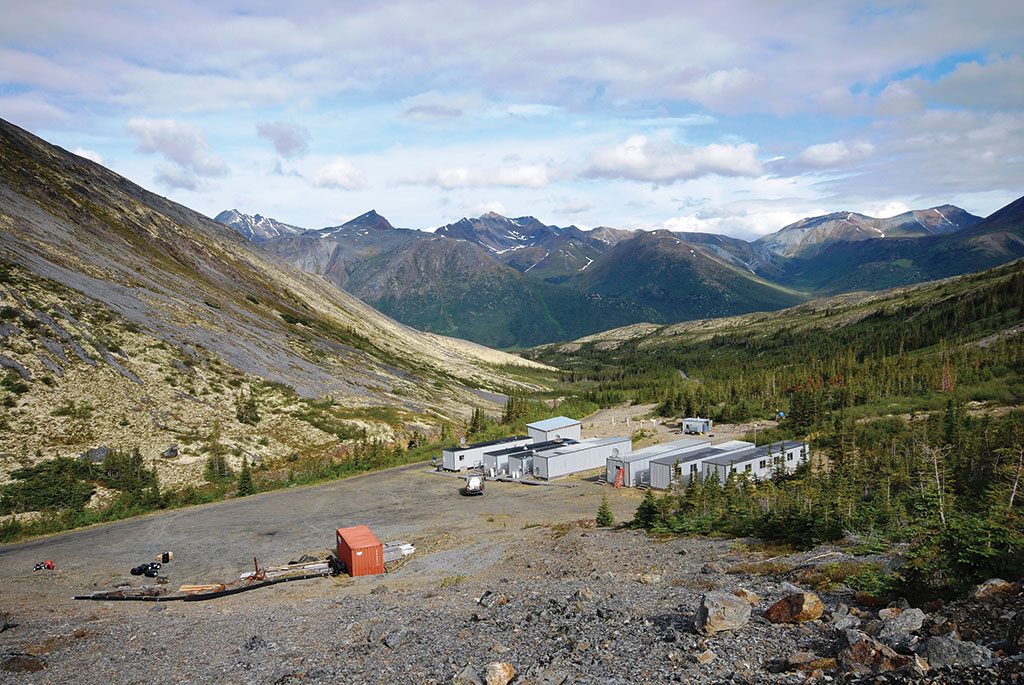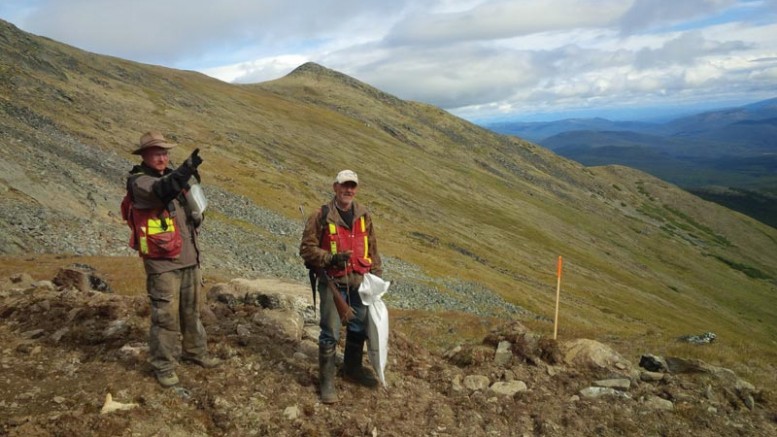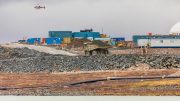The daunting task of exploring for minerals and developing mines in Canada’s Far North hasn’t dissuaded global mining companies from seeking riches in these underexplored regions. Here is a look at eight companies with substantial mineral assets in the country’s Far North.
ALEXCO RESOURCE
Alexco Resource (TSX: AXR; NYSE-AM: AXU) owns the historic Keno Hill silver district in the Yukon, and is working to resume commercial silver mining in the district through its Keno Hill silver project.
Alexco completed a positive prefeasibility study in March for expanded silver production at Keno Hill that envisages producing over an eight-year mine life total payable metals in concentrate of: 27.2 million oz. silver, 67.2 million lb. zinc and 65.4 million lb. lead. Average annualized contained silver-in-concentrate is 4 million oz. per year, based on full production years.

Alexco Resources’ president and CEO Clynton Nauman (R) and vice-president exploration Alan McOnie (L) stand outside the mill facility at the Keno Hill silver mine 330 km north of Whitehorse in Canada’s Yukon.
Initial capital costs are an estimated $23.2 million comprised of $17.9 million of surface and underground development costs to reach mill commissioning, plus $5.3 million of net working capital for two months of mill operations ramp-up prior to positive cash flow.
Alexco chairman and CEO Clynton Nauman said: “The results of the prefeasibility study reflect the exceptional asset we have in Keno Hill, and demonstrate a robust, high-margin primary silver operation that can produce approximately 4 million oz. silver per year. The operational and economic metrics of the study show an improvement over the previous preliminary economic assessment in nearly all categories including a higher net present value, increased annual silver production, lower capital requirements, improved operating costs and productivities, increased mine tonnage and throughput, lower life-of-mine, all-in-sustaining costs, and an impressive internal rate of return. With the results of the prefeasibility study now in-hand, we are on a clear path to production at Keno Hill.”
In April, Alexco raised $3.5 million via a bought-deal private placement of 1.84 million flow-through shares at $1.90 per share.
BAFFINLAND IRON MINES
Since 2015, privately held Baffinland Iron Mines has been mining one of the world’s highest quality iron ore deposits at its Mary River operation in the Qikiqtani region of North Baffin in Nunavut.
Baffinland is jointly owned by steel giant ArcelorMittal (NYSE: MT) and Nunavut Iron Ore, with its head office in Oakville, Ont., and its northern office in Iqaluit, the capital of Nunavut.

The camp and airstrip at Baffinland Iron Mines’ Mary River iron ore project on Baffin Island, Nunavut.
Mary River ore is so rich and close to surface that Baffinland’s operations — from mining through to crushing and shipping — all take place at its mine and port sites, with no processing or tailings involved. There are nine high-grade iron ore deposits on the property, and Baffinland is focused on exploiting Deposit No. 1, where it has completed more than 200 drill holes totalling more than 30,000 metres.
At the port, ore is loaded onto bulk-carrier ships during the ice-free summer season — typically from July to September — with Baffinland noting that most of its ships travel across the Atlantic Ocean and through European ports, with the cargo used by steelmakers in continental Europe.
Baffinland is considering expanding its Mary River operations in a two-phase plan that it says is “essential to the viability of the project,” and is involved in technical meetings and public hearings about the plan through 2019.
The expansion would cost $900 million and boost output to 30 million tonnes of iron ore per year, with the key feature being a 150 km railway from the Mary River iron mine site to an enlarged port on Milne Inlet.
BANYAN GOLD
Banyan Gold (TSXV: BYN; US-OTC: BYAGF) is focused on advancing two Yukon gold projects named Hyland and Aurex-McQuesten that the Vancouver-base junior says have “multimillion-ounce potential.”
Hyland in southeastern Yukon’s Tintina gold belt hosts an indicated resource of 8.6 million tonnes grading 0.85 gram gold-equivalent per tonne for 236,000 gold equivalent oz., plus an inferred resource of 10.8 million tonnes at similar grades. Banyan says this resource is located on what is known as the “Main Zone,” and is open in all directions.
Aurex-McQuesten is in the Mayo mining district, 56 km northeast from the village of Mayo, and 356 km north of Whitehorse, within the traditional territory of the Na-Cho Nyak Dun First Nation. Banyan acquired Aurex-McQuesten in 2016 from Alexco Resource and Victoria Gold, and says it is “highly prospective” for structurally controlled, intrusion-related gold-silver mineralization in relation to quartz monzonite dikes of the Tombstone intrusive suite. The property hosts numerous gold targets, and Banyan has developed a mineralization model at the McQuesten target.
In February, Banyan raised $450,000 via the first tranche of a non-brokered private placement of flow-through shares and warrants, with funds earmarked for exploration of its Yukon assets.
FIREWEED ZINC
Vancouver-based zinc explorer Fireweed Zinc (TSXV: FWZ; US-OTC: FWEDF) has been on bit of a roll, with consistent exploration successes at its Macmillan Pass zinc project in the Yukon and buoyant zinc prices being one of the few bright spots among the major metals in 2019.
Fireweed describes Macmillan Pass as “among the world’s most significant zinc resources” and hosting the Tom, Jason, Boundary zone and End zone zinc-lead-silver deposits.
In February the company raised $5 million in a non-brokered private placement, including a lead order by strategic investor Teck Resources. Teck’s participation brings its interest in the junior from 4.7% to 9.9%. Fireweed’s largest shareholder, RCF Opportunities Funds, also participated in the offering, acquiring 750,000 shares to keep its 13% stake. The money will be used on exploration and resource expansion at Macmillan Pass.

The Tom camp at Fireweed Zinc’s Macmillan Pass zinc-lead-silver project in the Yukon. Credit: Fireweed Zinc.
A May 2018 preliminary economic assessment outlined an 18-year mine life, with 32.7 million tonnes of mineralized material mined at an average processing rate of 4,900 tonnes per day. The study estimated average yearly contained metal production of 85,000 tonnes zinc, 48,000 tonnes lead and 2 million oz. silver. Pre-production capex was pegged at $404 million, with a four-year payback.
Fireweed completed a resource estimate in January 2018 for the Tom and Jason deposits. Together they contain an indicated resource of 11.2 million tonnes grading 6.59% zinc, 2.48% lead and 21.33 grams silver per tonne, for a zinc-equivalent grade of 9.61%. Inferred resources stand at 39.47 million tonnes grading 5.84% zinc, 3.14% lead and 38.15 grams silver per tonne, for a 10% zinc-equivalent grade.
The company’s executive chairman, John Robins, is a geologist and entrepreneur. Before Fireweed he was the founder, chairman and director of Kaminak Gold, which discovered the Coffee gold deposits in the Yukon, which were sold to Goldcorp for $520 million.
NIGHTHAWK GOLD
Toronto-based Nighthawk Gold (TSX: NHK; US-OTC: MIMZF) says it is developing “Canada’s next gold camp,” with control over 90% of the prospective and historic Indin Lake greenstone, 200 km north of Yellowknife in the Northwest Territories.
Its assets in the belt include an inferred resource at the Colomac project of 50.3 million tonnes grading 1.64 grams gold per tonne 2.6 million oz. gold.

Core shacks at Nighthawk Gold’s Colomac gold property in the Northwest Territories. Credit: Nighthawk Gold.
In a project update in April, Nighthawk said it has started its 2019 drilling program with three drills active at Colomac, and an exploration budget for the year of $10 million — which includes a minimum 25,000 metres of drilling (split between Colomac and select priority gold targets within its extensive regional land package), as well as the continuation of the regional mapping and prospecting program.
Of this amount, Nighthawk says $1 million will be spent on regional mapping and prospecting, which will continue to assess the land package for discoveries, and move targets up the value chain towards drill-ready status.
Its objectives are to continue the expansion of higher-grade mineralization intersected to date at Colomac, and explore for other zones of near-surface, higher-grade material within the Colomac area sills, culminating in the delivery of a resource update by early 2020.
Nighthawk president and CEO Michael Byron commented that “we are very pleased to be embarking upon our eighth drilling season at the Indin Lake Gold Property. We’ve had great success over the years rejuvenating the Colomac deposit into an ever growing, mutlimillion-ounce opportunity, with a new high-grade storyline, and exceptional metallurgy.”
The junior’s shareholder base includes Kinross Gold, Osisko Royalties and McEwen Mining.
SEABRIDGE GOLD
Toronto-based Seabridge Gold (TSX: SEA; NYSE: SA) continues its work advancing some of North America’s largest gold-copper deposits, most notably the KSM and Iskut properties near Stewart, B.C., and the Courageous Lake gold project in the Northwest Territories.
In March, Seabridge boosted the resource estimate for the Iron Cap deposit, which is one of four large gold-copper porphyry deposits within its wholly owned KSM project. The new resource figure incorporates all previous drilling, plus 20,341 metres of diamond core drilling in 18 holes during 2018.
Iron Cap’s indicated resources now stand at 423 million tonnes grading 0.41 gram gold per tonne, 0.22% copper, 4.6 grams silver per tonne and 41 parts per million molybdenum, while inferred resources have swelled to 1.9 billion tonnes at 0.45 gram gold, 0.30% copper, 2.6 grams silver and 30 parts per million molybdenum.

A drill site at Seabridge Gold’s KSM gold-copper project, 65 km northwest of Stewart, British Columbia. Credit: Seabridge Gold
Seabridge says the new resource estimate has “achieved the targeted size and grade, which are likely to warrant moving the Iron Cap deposit ahead of the Kerr and Sulphurets deposits in the project’s mine plan.”
It adds that its exploration success at Iron Cap over the past two years has given it greater flexibility to optimize project economics, with Iron Cap being closer to infrastructure than Kerr and Sulphurets, and thus its development could be faster and less costly. It says there exist significantly higher-grade underground cave opportunities with substantial tonnage, and that Iron Cap “clearly has the size and grade to justify early inclusion in the mining sequence.”
Due to its 2018 exploration program, Seabridge notes that it added 460,000 indicated oz. gold resources and 7.5 million oz. inferred gold resources.
SILVER RANGE RESOURCES
Vancouver-based junior Silver Range Resources (TSXV: SNG; US-OTC: SLRRF) is led by seasoned president and CEO Michael A. Power, and bills itself as a “high-grade, precious metals project generator.”
The company has 42 properties — mostly across Nevada and northern Canada — including 16 projects, and it says it is “ready to deal.”
In April, Silver Range entered into a shares-for-services agreement with Paladin Geoscience, a private company controlled by Silver Range’s president and CEO Power, whereby Paladin will provide geological and other consulting services to Silver Range, with half its fees paid in cash and half in Silver Range shares at market rates.

Silver Range Resources’ mapping and prospecting crew at the high-grade Hard Cash gold property in southern Nunavut in mid-2017. Credit: Silver Range Resources.
Silver Range said in March it had started exploration in Nevada, and added that “in light of current market conditions and the opportunities they create, the company will concentrate on identifying and acquiring cost-effective targets with asymmetric risk-reward profiles, and on internal economies to reduce non-operational expenditures.”
In Nunavut, Canarc Resources (TSXV: CCM) informed Silver Range that its would drill the Hard Cash property in 2019, where a 3.4 km trend of high-grade surface rock samples follow a magnetic break and an electromagnetic resistivity low. In-situ surface exposures along this trend have assayed up to 125 grams gold per tonne and 719 grams silver per tonne. Canarc can earn a 100% interest in Hard Cash, subject to a 2% royalty and success fees, by making staged payments totalling $150,000 and issuing Silver Range 1.5 million shares.
VICTORIA GOLD
Toronto-based mine developer Victoria Gold (TSXV: VIT; US-OTC: VITFF) is on the cusp of completing construction of Canada’s newest gold mine at its Eagle project in central Yukon.
Victoria reports that construction is on target for the company to pour first gold in the second half of 2019. In full production, Eagle will produce 200,000 oz. gold per year for 10 to 11 years, and will be the largest gold mine in Yukon history.

Crushers under construction with the gold recovery plant in the distance, at Victoria Gold’s Eagle gold mine in the Yukon. Credit: Victoria Gold.
The Eagle mine site is on Victoria’s wholly owned Dublin Gulch gold property, 375 km north of the capital city of Whitehorse, and 85 km from the town of Mayo, with the property being accessible by road year round, and located within Yukon Energy’s electrical grid.
The Eagle project’s Eagle and Olive deposits include proven and probable reserves of 2.7 million contained oz. gold in 123 million tonnes grading 0.67 gram gold per tonne.
The measured and indicated resource, inclusive of reserves, stands at 208 million tonnes at 0.66 gram gold for a contained 4.4 million oz. gold. Another 20 million tonnes at 0.64 gram gold lie in the inferred category.





Be the first to comment on "Far North Snapshot: Eight companies active in Canada’s Far North"